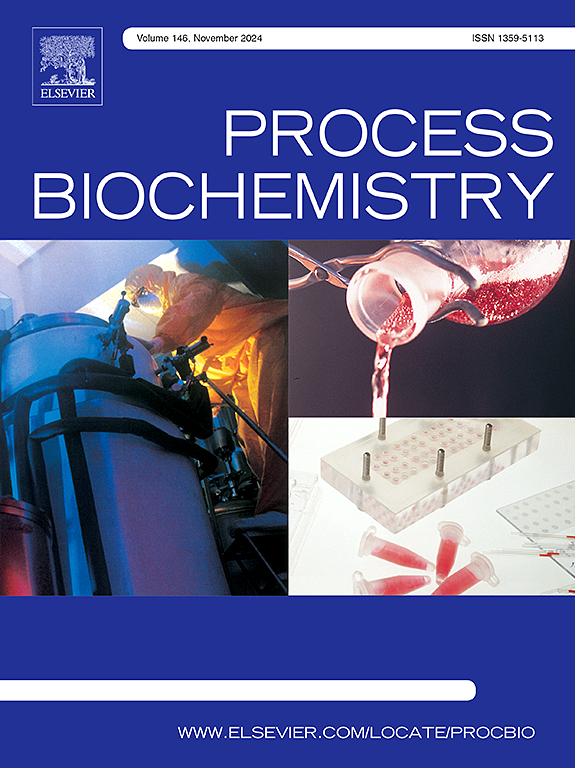银杏叶衍生的两亲性和生物相容性碳点用于杀菌和MRSA生物膜破坏
IF 4
3区 生物学
Q2 BIOCHEMISTRY & MOLECULAR BIOLOGY
引用次数: 0
摘要
以耐甲氧西林金黄色葡萄球菌(MRSA)为代表的耐多药(MDR)细菌感染已成为全球卫生保健系统面临的严峻挑战。因此,抗菌碳点(cd)在对抗MRSA方面引起了越来越多的兴趣。本研究采用简单的一步溶剂热法结合萃取技术合成了氮自掺杂银杏叶碳点(GLCDs)。制备的GLCDs为球形纳米颗粒,具有晶体结构,正电荷为+ 7.62 mV。GLCDs对MRSA的最低抑制浓度(MIC)为250 μg/mL。值得注意的是,在750 μg/mL的浓度下,GLCDs可以在240 分钟内完全消除1 × 106 MRSA,并有效抑制MRSA生物膜的形成,且具有剂量依赖性。抗菌机制包括静电相互作用,使其渗透到MRSA中,破坏细胞结构导致细胞内成分泄漏,诱导氧化应激,抑制抗氧化酶和呼吸功能。此外,glcd在溶血和体外细胞毒性试验中表现出良好的生物相容性。本研究提出了一种新的天然植物基抗菌纳米材料,为合理利用天然生物质对抗MRSA感染提供了有价值的见解。本文章由计算机程序翻译,如有差异,请以英文原文为准。
Ginkgo leaf derived amphiphilic and biocompatible carbon dots for sterilization and MRSA biofilm destruction
Multidrug-resistant (MDR) bacterial infections, typified by methicillin-resistant Staphylococcus aureus (MRSA), have become a severe global challenge to healthcare systems. In response, antibacterial carbon dots (CDs) have attracted growing interest in the fight against MRSA. In this study, nitrogen self-doped ginkgo leaf (GL) carbon dots (GLCDs) were synthesized through a facile one-step solvothermal method combined with extraction technology. The prepared GLCDs are spherical nanoparticles with a crystalline structure and carry a positive charge of + 7.62 mV. The minimum inhibitory concentration (MIC) of GLCDs against MRSA was found to be 250 μg/mL. Notably, at a concentration of 750 μg/mL, GLCDs could completely eliminate 1 × 106 MRSA within 240 minutes and effectively suppress MRSA biofilm formation in a dose-dependent manner. The antimicrobial mechanisms involve electrostatic interaction enabling penetration into MRSA, disruption of the cell structure leading to intracellular component leakage, induction of oxidative stress, and inhibition of antioxidant enzymes and respiratory function. Moreover, GLCDs demonstrated excellent biocompatibility in hemolysis and in vitro cytotoxicity tests. This research presents a novel natural-plant-based antimicrobial nanomaterial, providing valuable insights into the rational utilization of natural biomass to combat MRSA infections.
求助全文
通过发布文献求助,成功后即可免费获取论文全文。
去求助
来源期刊

Process Biochemistry
生物-工程:化工
CiteScore
8.30
自引率
4.50%
发文量
374
审稿时长
53 days
期刊介绍:
Process Biochemistry is an application-orientated research journal devoted to reporting advances with originality and novelty, in the science and technology of the processes involving bioactive molecules and living organisms. These processes concern the production of useful metabolites or materials, or the removal of toxic compounds using tools and methods of current biology and engineering. Its main areas of interest include novel bioprocesses and enabling technologies (such as nanobiotechnology, tissue engineering, directed evolution, metabolic engineering, systems biology, and synthetic biology) applicable in food (nutraceutical), healthcare (medical, pharmaceutical, cosmetic), energy (biofuels), environmental, and biorefinery industries and their underlying biological and engineering principles.
 求助内容:
求助内容: 应助结果提醒方式:
应助结果提醒方式:


